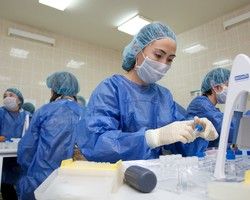European Laboratory Initiative on TB, HIV and Viral Hepatitis sets priorities for integrated testing and diagnosis in 2020–2021

Research Institute of Influenza, Russian Federation/Kirill Sirotyuk
The European Laboratory Initiative on TB, HIV and Viral Hepatitis (ELI), a regional network supporting a joint, patient-centred response to the 3 diseases, has set priorities for the next 2 years to improve integrated diagnostic services.
Late diagnosis remains a challenge especially in countries of central Asia and eastern Europe. It delays the start of treatment and reduces the likelihood of its success and increases the risk of further TB and HIV transmission, as well as the development and spread of drug-resistant TB.
Diagnostic and treatment monitoring platforms are increasingly able to diagnose HIV and viral hepatitis, and coinfections of HIV and TB or viral hepatitis; however, the response to these interrelated diseases has largely remained vertical from a health system perspective. Integrating programmes benefits patients by maximizing available infrastructure and resources while minimizing diagnostic and therapeutic delay for patients with multiple infections.
6 priorities to ensure integrated, effective and efficient use of laboratory and diagnostic tools
ELI identified 6 priorities for action for 2020–2021:
- Develop a strategy to improve the quality of drug susceptibility testing for TB across the Region through the implementation of a comprehensive quality assurance dashboard, following the development and successful piloting of the dashboard in 2019.
- Introduce the new WHO recommended HIV testing algorithm in selected countries. This follows the latest WHO recommendations urging countries to shift to accurate, simpler rapid tests and removing the use of Western blot.
- Map national TB laboratories’ capacities to accurately identify resistance to the drugs currently used for the treatment of drug-resistant TB.
- Include a behavioural science approach in ELI’s communication strategies to broaden and strengthen buy-in and implementation of recommendations by key stakeholders.
- Develop a people-centred strategy to increase access to and use of testing services by key and vulnerable populations (e.g. using mobile laboratories).
- Train trainers to build a regional pool of laboratory safety advisers based on international standards.
ELI core group members agreed to focus their efforts on these priorities at their annual meeting, held in Copenhagen, Denmark, on 14–15 Nov 2019, with the aim of making a more integrated, effective and efficient use of laboratory and diagnostic tools in the WHO European Region. At this second meeting since 2018, when ELI’s scope was extended to HIV and viral hepatitis in addition to TB, core group members reinforced their willingness to reach a better balance through the recent call for applications for HIV and viral hepatitis experts to join the core group.
About ELI
ELI’s mandate covers laboratory diagnostics, testing and treatment monitoring needs for TB, HIV and viral hepatitis. The initiative serves as a regional platform for discussion and communication on laboratory diagnosis and testing for the 3 diseases, and for providing policy guidance and advice. ELI core group members function as an independent technical advisory and support group to WHO and partners.



